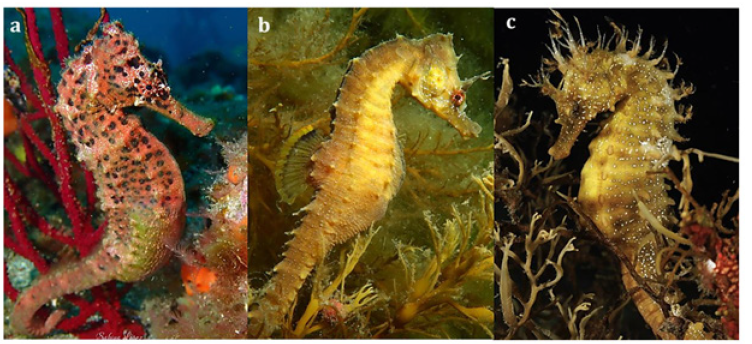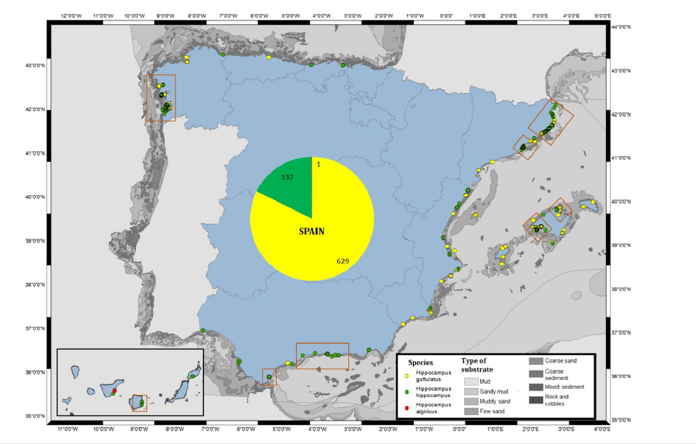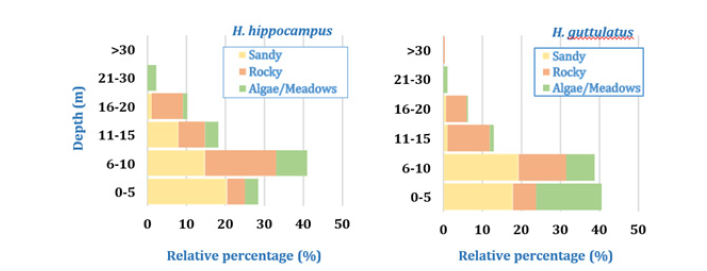- Submissions

Full Text
Biodiversity Online J
Mapping Seahorses Along the Spanish Coasts: Preliminary Insights from Citizen Science
Planas M*, Pereira S, Fernández J and Hernández UJ
Department of Marine Ecology and Resources, Institute of Marine Investigations (IIM-CSIC), Vigo, Spain
*Corresponding author:Miquel Planas, INMARE, Department of Marine Ecology and Resources, Institute of Marine Research (IIM-CSIC), Vigo, Spain
Submission: October 04, 2024; Published: October 18, 2024

ISSN 2637-7082Volume5 Issue1
Abstract
Seahorses are vulnerable due to habitat loss, overfishing, and pollution. Understanding their distribution
is crucial for conservation. Citizen Science (CS) initiatives offer valuable tools for collecting large-scale
data of marine species, including seahorses. This study used citizen science data to investigate seahorse
distribution along the Spanish coast, including Balearic and Canary Islands. Data from the CS platform
Observadores del Mar were analyzed for seahorse occurrence. We identified significant gaps in coverage,
particularly in the Cantabrian littoral and some Mediterranean areas. The presence of three species
were confirmed: H. algiricus (only present in Canary Islands), H. hippocampus, and H. guttulatus (absent
in Canary Islands). Notably, our study revealed a lower abundance of H. hippocampus compared to H.
guttulatus, especially in the Mediterranean. We also observed a preference for sandy areas and deeper
depths in H. hippocampus. Due to the extremely limited observations of H. algiricus, we are unable to
provide ecological information at this time. This study highlights
a) The value of CS in understanding seahorse distribution and informing future conservation
initiatives, and
b) The need for targeted conservation efforts in areas with scarce seahorse observations.
Keywords:Hippocampus; Seahorse; Distribution; Spain; Citizen science; Conservation
Keywords:Abbreviations:CS: Citizen Science, GIS: Geographic Information System, IUCN: International Union for Conservation of Nature, OdM: Observadores del Mar
Introduction
Seahorses (Hippocampus spp.) are charismatic fish with unique morphological adaptations. Their vulnerability to habitat loss, overfishing, and pollution has made them a focus of conservation efforts worldwide [10,1]. Unfortunately, due to a lack of sufficient data, numerous species are still categorized as Data Deficient by the IUCN. Understanding seahorse distribution is crucial for effective management and protection. CS initiatives are valuable tools for collecting large-scale data on species [2-4], including seahorses [5-7]. We used CS data to investigate the occurrence of seahorses along the Spanish coast, including the Balearic and Canary Islands. We provide preliminary insights into the spatial patterns of seahorse distribution. Our findings will contribute to a better understanding of seahorse ecology and inform conservation efforts in these regions.
Materials and Methods
We used Citizen Science (CS) data (period 2006-2023) from the Observadores del Mar (OdM) platform to examine seahorse distribution along the Spanish coast, including the Balearic and Canary Islands. The observations were validated by expert review. ArcGIS 10.8 software [8] was employed for mapping.
Results and Discussion
A total of 767 observations were analysed, including H. algiricus Kaup, 1856 (n=629), H. hippocampus (n=137), and H. guttulatus Cuvier, 1829 (n=1) (Figure 1). The data analysis revealed a significant disparity in observational coverage across different regions of the Spanish coast (Figure 2). The Cantabrian Arc and some parts of the Mediterranean coast were identified as areas with limited data. The species H. guttulatus was more abundant than H. hippocampus, particularly in the Mediterranean (Table 1). This pattern is consistent across European coastal regions [9- 12]. Although both species often co-occur, H. guttulatus prefers shallower complex habitats that are sheltered from strong currents [11]. Nearly half of all observations (42.1% for H. hippocampus; 47.7% for H. guttulatus) were recorded at depths between 6 and 10m. Beyond 15m, the number of observations decreased significantly (12.4% and 10.1%, respectively). At depths greater than 30m, only a single individual of H. hippocampus was observed (38m), in a sandy area devoid of vegetation. The presence of H. hippocampus (27.3%) in the shallowest zone (0-5 meters) was almost double that of H. guttulatus (14.6%). Considering the habitat types (sandy, rocky, seagrass meadow-macroalgae, and others) available for selection on the OdM platform, H. hippocampus showed a greater preference for sandy bottoms (44.8% of total observations) compared to H. guttulatus (37.9%) and a lower preference for seagrass meadows (17.1% in H. hippocampus and 28.2% in H. guttulatus). When assessing the number of specimens in relation to depth and habitat type, a higher relative occurrence of H. hippocampus was noted in sandy areas over seagrass meadows and at greater depths, compared to H. guttulatus (Figure 3). Beyond 10 meters, the presence of specimens decreased considerably, with a greater preference for rocky areas.
Figure 1:Species on the Spanish coasts:
a) H. algiricus (male) ©Sabina López
b) H. hippocampus (male) ©Fernando Quintela
c) H. guttulatus (female) ©Xaime Beiro

Table 1:Seahorse observations grouped by geographical region.

Figure 2:Occurrence of seahorse species along the Spanish coast (Source: OdM). Substrate data (standardized EUNIS format) from EMODNET. Red squares indicate key seahorse hotspots. Base map: Service of the National Geographic Information Center

Figure 3:Percentage distribution of seahorse specimens across habitat types, categorized by depth range.

Conclusion
The data provided valuable information on the spatial patterns of seahorse occurrence and identified areas with limited information. Hence, the study demonstrates the effectiveness of CS in contributing to marine conservation research and informing future conservation initiatives for the long-term survival of seahorses. However, the limited availability of CS data restricted the scope of this study. Besides this, while CS data has greatly enhanced our ability to collect population data, it comes with certain limitations. For seahorse observations made by scuba divers, depth is a significant constraint, as most dives do not go deeper than 15-20 meters, with only rare exceptions reaching 30 meters. Consequently, populations at greater depths are often overlooked. To expand the database and gain a more comprehensive understanding of seahorse distribution, we must actively engage the public and encourage their involvement in data collection, especially in understudied regions. Additionally, a recent study on the distribution of seahorses in the Gulf of Cadiz and nearby areas [13] highlighted the need for an inclusive approach engaging a diverse range of contributors (e.g., other CS portals, fishermen, and fisheries/oceanographic campaigns) to generate additional data.
Acknowledgements
Study funded by the Ministry for the Ecological Transition and Demographic Challenge (MITERD) through the Hippo-DEC Project (Ref. 20233TE008). Seahorse photos are from validated observations reported by the OdM community. The authors thank the OdM staff, observers, staff of the Spanish Autonomous Communities and collaborating entities for their support.
Conflict of interest
All authors declare that they have no conflicts of interest.
References
- Foster SJ, Vincent ACJ (2004) Life history and ecology of seahorses: Implications for conservation and management. Journal of Fish Biology 65: 1-61.
- Cerrano C, Milanese M, Ponti, M (2017) Diving for science‐science for diving: Volunteer scuba divers support science and conservation in the Mediterranean Sea. Aquatic Conservation: Marine and Freshwater Ecosystems 27(2): 303-323.
- Dickinson JL, Shirk J, Bonter D, Bonney R, Crain RL, et al. (2012) The current state of citizen science as a tool for ecological research and public engagement. Frontiers in Ecology and the Environment 10(6): 291-297.
- Follett R, Strezov V (2015) An analysis of citizen science based research: Usage and publication patterns. PLoS One 10: e0143687.
- Bosso L, Panzuto R, Balestrieri R, Smeraldo S, Chiusano ML, et al. (2024) Integrating citizen science and spatial ecology to inform management and conservation of the Italian seahorses. Ecological Informatics 79: 102402.
- Castejón SI, Terrados J, Morales NB (2023) Citizen science in the study of marine biodiversity: The case of iconic and cryptic syngnathids. Thalassas 39: 679-686.
- Goffredo S, Piccinetti C, Zaccanti F (2004) Volunteers in marine conservation monitoring: A study of the distribution of seahorses carried out in collaboration with recreational scuba divers. Conservation Biology 18(6): 1492-1503.
- Esri R (2011) ArcGIS desktop: release 10. Environmental Systems Research Institute. CA 634: 315- 325.
- Correia M (2022) Monitoring of seahorse populations, in the ria formosa lagoon (Portugal), reveals steep fluctuations: Potential causes and future mitigations. Proceedings of the Zoological Society 75(2): 190-199.
- Correia M, Caldwell IR, Koldewey HJ, Andrade JP, Palma J (2015) Seahorse (Hippocampinae) population fluctuations in the Ria Formosa Lagoon, south Portugal. Journal of Fish Biology 87(3): 679-690.
- Curtis J, Vincent A (2005) Distribution of sympatric seahorse species along a gradient of habitat complexity in a seagrass-dominated community. Marine Ecology Progress Series 291: 81-91.
- Gristina M, Cardone F, Carlucci R, Castellano L, Passarelli S, et al. (2015) Abundance, distribution and habitat preference of Hippocampus guttulatus and Hippocampus hippocampus in a semi‐enclosed central Mediterranean marine area. Marine Ecology 36(1): 57-66.
- Ruíz JI, Hernández UJ, Pereira S, Sobrino I, López JA, et al. (2024) Occurrence of seahorses Hippocampus spp. in the southernmost part of Western Europe and new maximum depth record. Animals 14(16): 2328.
© 2024 Planas M. This is an open access article distributed under the terms of the Creative Commons Attribution License , which permits unrestricted use, distribution, and build upon your work non-commercially.
 a Creative Commons Attribution 4.0 International License. Based on a work at www.crimsonpublishers.com.
Best viewed in
a Creative Commons Attribution 4.0 International License. Based on a work at www.crimsonpublishers.com.
Best viewed in 







.jpg)






























 Editorial Board Registrations
Editorial Board Registrations Submit your Article
Submit your Article Refer a Friend
Refer a Friend Advertise With Us
Advertise With Us
.jpg)






.jpg)














.bmp)
.jpg)
.png)
.jpg)










.jpg)






.png)

.png)



.png)






